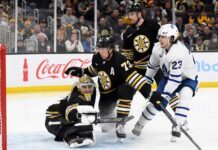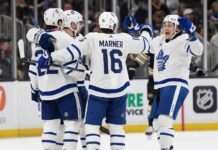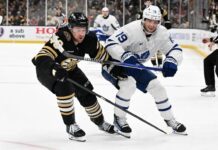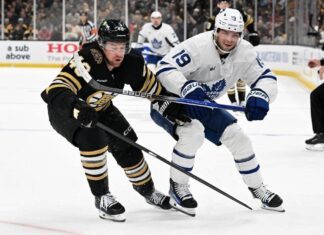I know, you—re worried about value for Vesa Toskala and Tomas Kaberle. Well, don—t. Their recent performance(s) are killing their market value, right?
No. Market forces and low-ball offers may hinder dealing them now, but as the trade deadline approaches, true value is more likely for the Buds. And that—s good, because both players are underperforming.
Being in full evaluation/negotiation mode in fantasy leagues, posturing for position and propping up a sagging roster, it got me to thinking about reality-based trade evaluation, and how appraisals are distorted by current production .. or lack thereof.
Its weighting is minimal in most negotiations amongst NHL GM—s, very different from fantasy where stats rule and usually a derivative of this: ˜I love how he—s playing and increasing his potential trade value ¦ Or, He—s stinking up the joint, and dropping his trade value ¦
And I shake my head.
Most rhetoric is directed to recent play of Toskala and Kaberle, with intermittent reference to other Leafs. Fans speculate about possible returns for the rebuilding outfit as if current performance holds significant relevance in trade talks.
Detroit—s Henrik Zetterberg had two measly points in five games leading to the Winter Classic, making my fantasy Stinking list at McKeen—s Hockey. He scored his first goal in 10 games (10-1-7-8) against Columbus. Has his value diminished?
If value was based on current performance, Toronto wouldn—t have sent a first round pick to San Jose for Toskala — a ˜backup— at the time — and Michael Ryder would not have been offered a 3-year, $12 million deal this past summer with the Bruins.
Steen and Carlo and Brandon
Alex Steen (20-2-2-4) and Carlo Colaiacovo (10-0-1-1) underperformed early on with the Buds, yet still netted Lee Stempniak, who was el fuego in the eight games prior (8-3-9-11).
Chicago acquired Calder Trophy candidate, Kris Versteeg, from Boston sending Brandon Bochenski the other way; the same player who ripped it up in exhibition play on a line with Dany Heatley and Jason Spezza coming out of the lockout and worn five jerseys since. Despite 24 goals in 124 games, he is currently with Norfolk in the AHL.
Some GM—s overpay for unrestricted free agents based on current production, with Dainius Zubrus and Ryan Malone (who is coming out of his funk) as examples, signing long term contracts coming off 20-plus goal seasons. David Legwand signed a monster deal last season and ever since has been injury-prone and a fantasy dud. Try prying him away from the Predators, however, and his realistic value is another matter.
Closer to home, the Buds gave Pavel Kubina $5 million — at an awkward time for exorbitant salaries — and offered Jeff Finger $3.5 million as an unknown commodity.
Jason LaBarbera was sent to the Canucks in exchange for a low, 7th round pick. Atlanta offered Ron Hainsey a monster 5-year, $22.5 million deal after striking out for a puck moving blueliner. Think the invisible hand of the market theory dominated that offer?
Skill, Fit and Value
It—s all about skill, what players can contribute in club—s silks in specific roles, not how they are playing right now.
Scouts/management evaluate players and file reports; general outlook, specific skills/deficiencies and evaluation on fit in the potential suitor—s outfit. Performance in the last game, 10 games, or even a season means very little. Michael Ryder scored 14 goals in 70 games last season with the Habs, matching that in 36 games with Boston. He—s given the B—s more scoring depth up front.
In addition to skill, fit and market value contribute to the acquisition price for a player.
NHL cubs generally don—t look at standings or player statistics. They discreetly send scouts to observe (like Columbus recently). Not necessarily watching the game, they isolate targeted player(s) in real game situations, and scrutinize on the basis of their organization—s specific criteria.
Teams build rosters mainly through homegrown methods (draft) and plug holes with deals of identified and targeted players, analyzing player—s individual skills as fits in their own lineup.
Trades are self-serving, made to enhance lineups (rentals), stabilize rosters (veteran depth) or acquire assets. GM—s evaluate rosters, consult with scouts for skills and other sources to verify intangibles like personality and character.
Market forces determine actual prices, more so than production. Cristobal Huet went for a 2nd round pick to the Washington Capitals as a potential free agent at the end of the season. Is Toskala worth more than a 2nd rounder, even if skills are worthy of more? Will the market dictate a lessened return?
A 50-goal scorer isn—t described as a 50-goal scorer among scouts. The skills (hands/speed/awareness etc) contributing to goal-scoring ability offer greater distinction. Remember Gary Leeman? He scored 50 goals once.
Life is Just a Fantasy .. Can You Live a Fantasy Life
But, we live in a fantasy and NHL 2K9 world.
We amuse and feed our passion by using valuations from fantasy leagues and video games that seep into everyday thoughts with a superficial yo-yo effect on a player—s realistic value. In fantasy, this bears relevance; in reality, not so much. There are two sides to every transaction. Stats and current performance are less relevant to reality-based swaps.
Factors weighted higher in valuations:
Natural talent (skill)
Age
Size/Mobility
Awareness (both sides of the puck)
Scoring ability (or lack thereof)
Offensive/Defensive aggressiveness (or lack thereof)
Personality/Character/Will to win/passion for the game
Market factors (player availability with similar skill sets; price adjustments for flood/lack of assets).
After this analysis, individual stats are possibly considered, within context.
When it comes to Toronto, speculation rules in the passionate environment. I shake my head when Leafs fans appear downhearted at the on-ice play, feeling like their assets are being devalued. It—s not the case throughout the NHL and definitely not for the Buds.
Let GM(s) determine value. Your job(s) are to enjoy the games and look forward to a consistently brighter future.


































